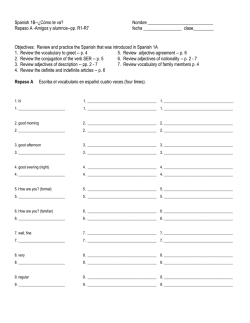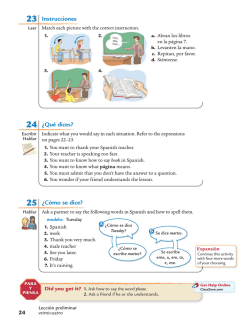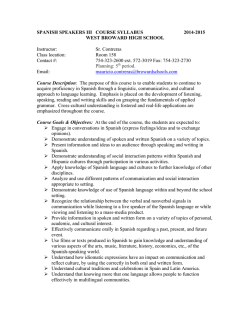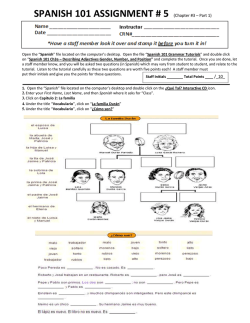
The socioeconomic and gender stratification of Chilean Spanish
The socioeconomic and gender stratification of Chilean Spanish vowel allophones Scott Sadowsky, Catholic University of Chile While vowels have long been central to the study of sociolinguistic variation in English, relatively little scholarly attention has been paid to vowel variation in Spanish, and the bulk of this research has focused on geographic differences, such as those found in Eastern Andalusia (Salvador 1987) and the American Southwest (Willis 2005). The dearth of studies of the social correlates of Spanish vowels seems to be due to the assumption that little such variation actually exists (Colantoni 2011). The social stratification of various consonant allophones in Chilean Spanish was first observed by Lenz (1940 [1892-3]), and has been explored by subsequent research (e.g., Bobadilla and Bobadilla 1980; Valencia 1993; Figueroa et al. 2010; Sadowsky 2015). Further social variation has been found in the clitic system (Silva-Corvalán 2001), voseo verb forms (González Vergara 2002) and the lexicon (Contardo 2008). These rich and diverse correlations between socioeconomic level and language features suggest that such patterns are likely to manifest themselves in the vowel system as well. This study examines the speech of a socioeconomically stratified sample of 61 young adult speakers of Chilean Spanish from the Province of Concepción, the country’s second-largest metropolitan area, in order to determine what, if any, patterns of socioeconomic and gender stratification exist in their vowel allophones. 30 female and 31 male speakers, aged 16 to 19, were stratified using a modified version of the ESOMAR scale (Adimark 2000). A total of 6547 vowel tokens were elicited using a reading-based task in order to insure results would be comparable to those of other studies of Spanish vowels, which only exceptionally analyze semispontaneous speech. Vowels were normalized with the Nearey 1 algorithm (Nearey 1977) as implemented in the vowels R package (Kendall and Thomas 2014). Results were analyzed with the Rbrul R package (Johnson 2016), using F1 and F2 as dependent variables, and speaker, gender, SEL, and left and right phonological context as independent variables. A preliminary analysis showed that speakers’ vowels vary depending on whether they are in prestressed, stressed or post-stressed position. Each of the five vowel phonemes were therefore subdivided into three stress categories for further analysis, giving a total of 15 “vowel classes”. Controlling for socioeconomic level, the vowels of male and speakers differed significantly in 12 of the 15 vowel classes (in F1 alone in four cases, in F2 alone in one case, and in both formants in seven cases). With regard to socioeconomic variation, three vowel classes exhibited a statistically significant correlation with SEL in female speakers (pre-stressed /i/, stressed /e/ and post-stressed /u/), while three different vowel classes exhibited such correlation in male speakers (pre-stressed /a/ and /u/, and post-stressed /i/). The extreme gender stratification of vowel allophones suggests they play a key role in gender identity, while the six cases of social stratification suggest that other socially stratified features of Chilean Spanish are insufficient to meet speakers’ needs to create and recognize social identities. REFERENCES Adimark. 2000. El Nivel Socio Económico Esomar. Manual de Aplicación. Santiago: Admiark. Bobadilla, Félix, and Gustavo Bobadilla. 1980. El estudio de tres variables sociolingüísticas en Rancagua: problemas preliminares. Boletín de Filología 31: 721–741. Colantoni, Laura. 2011. Laboratory Approaches to Sound Variation and Change. In The Handbook of Hispanic Sociolinguistics, ed. Manuel Díaz-Campos, 9–35. Oxford: WileyBlackwell. Contardo, Óscar. 2008. Siútico. Santiago: Vergara. Figueroa, Mauricio, Jaime Soto-Barba, and Marco Ñanculeo. 2010. Los alófonos del grupo consonántico /tr/ en el castellano de Chile. Onomázein 22: 11–42. González Vergara, Carlos. 2002. La variación “eríh” / “soi” en el voseo verbal de Santiago de Chile. Un estudio exploratorio. Onomázein 7: 213–230. Johnson, Daniel Ezra. 2016. Rbrul. R package (version 2.3.2). Kendall, Tyler, and Erik R. Thomas. 2014. Vowels: Vowel Manipulation, Normalization and Plotting in R. R package (version 1.2-1). Lenz, Rodolfo. 1940 [1892-93]. Estudios Chilenos I-VII. In El español en Chile. Trabajos de Rodolfo Lenz, Andrés Bello y Rodolfo Oroz, ed. Amado Alonso and Raimundo Lida, 84– 208. Biblioteca de Dialectología Hispanoamericana VI. Buenos Aires: Facultad de Filosofía y Letras de la Universidad de Buenos Aires. Nearey, Terrance M. 1977. Phonetic Feature Systems for Vowels. Reprinted 1978 by the Indiana University Linguistics Club, University of Alberta Ph.D. dissertation. Sadowsky, Scott. 2015. Variación sociofonética de las consonantes del castellano chileno [Sociophonetic variation in Chilean Spanish consonants]. Sociolinguistic Studies 9: 71– 92. doi:10.1558/sols.v9i1.19927. Salvador, Gregorio. 1987. Estudios dialectológicos. Madrid: Paraninfo. Silva-Corvalán, Carmen. 2001. Sociolingüística y pragmática del español. Washington: Georgetown University Press. Valencia, Alba. 1993. Realizaciones de /s/, /ĉ/ y /ĵ/ en el habla adolescente. Nueva Revista del Pacífico 38–39: 159–180. Willis, Erik. 2005. An initial examination of southwest Spanish vowels. Southwest Journal of Linguistics 24: 185–198.
© Copyright 2026




